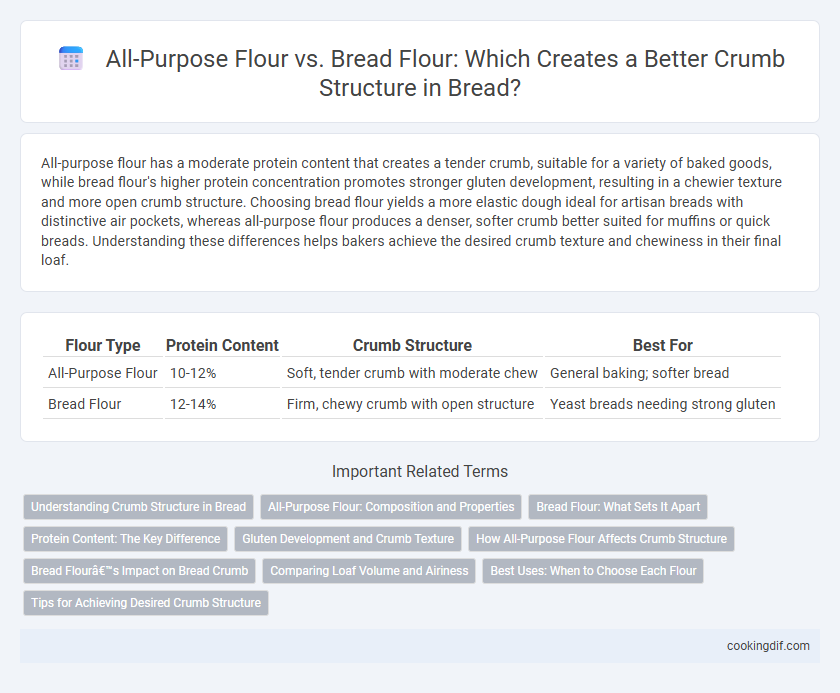All-purpose flour has a moderate protein content that creates a tender crumb, suitable for a variety of baked goods, while bread flour's higher protein concentration promotes stronger gluten development, resulting in a chewier texture and more open crumb structure. Choosing bread flour yields a more elastic dough ideal for artisan breads with distinctive air pockets, whereas all-purpose flour produces a denser, softer crumb better suited for muffins or quick breads. Understanding these differences helps bakers achieve the desired crumb texture and chewiness in their final loaf.
Table of Comparison
| Flour Type | Protein Content | Crumb Structure | Best For |
|---|---|---|---|
| All-Purpose Flour | 10-12% | Soft, tender crumb with moderate chew | General baking; softer bread |
| Bread Flour | 12-14% | Firm, chewy crumb with open structure | Yeast breads needing strong gluten |
Understanding Crumb Structure in Bread
All-purpose flour typically contains 10-12% protein, producing a moderately open crumb structure suitable for softer, more tender breads, while bread flour has a higher protein content of 12-14%, promoting greater gluten development and resulting in a chewier, more elastic crumb. The increased gluten in bread flour creates a stronger dough network that traps gas bubbles more effectively, leading to better rise and a distinctively airy crumb with larger holes. Understanding these protein differences is essential for bakers aiming to control crumb texture and achieve desired bread characteristics.
All-Purpose Flour: Composition and Properties
All-purpose flour typically contains 10-12% protein, which provides moderate gluten development ideal for tender crumb structures in various baked goods. Its balanced blend of hard and soft wheat varieties results in versatile performance, allowing for softer, less chewy bread compared to bread flour. The moderate gluten network formed in all-purpose flour contributes to a finer, more delicate crumb texture, suitable for sandwich loaves and soft rolls.
Bread Flour: What Sets It Apart
Bread flour contains higher protein content, typically 12-14%, which develops more gluten, resulting in a chewier and denser crumb structure compared to all-purpose flour. This enhanced gluten network traps gases more effectively during fermentation, leading to better rise and a more elastic texture ideal for artisan breads and rolls. Its superior strength and absorption capacity make bread flour the preferred choice for bakers aiming for a distinct, airy crumb with improved volume.
Protein Content: The Key Difference
Protein content in flour fundamentally affects crumb structure, with bread flour typically containing 12-14% protein compared to all-purpose flour's 10-12%. Higher protein levels in bread flour develop more gluten strength, resulting in a chewier, more elastic crumb ideal for artisanal breads and pizza dough. All-purpose flour's moderate protein content yields a softer, finer crumb suitable for cakes and muffins but less optimal for robust bread textures.
Gluten Development and Crumb Texture
Bread flour contains higher protein content, typically 12-14%, which promotes greater gluten development, resulting in a chewier and more elastic crumb structure ideal for artisanal loaves. All-purpose flour, with protein content around 10-12%, yields a softer, less chewy crumb due to its moderate gluten formation, making it suitable for tender bread varieties. Choosing bread flour enhances crumb texture by creating a more open and resilient crumb, while all-purpose flour produces a finer, denser crumb.
How All-Purpose Flour Affects Crumb Structure
All-purpose flour contains a moderate protein content, typically around 10-12%, which produces a tender crumb with a softer texture in baked bread. The lower gluten potential compared to bread flour leads to a less elastic dough, resulting in a crumb that is more open and less chewy. This makes all-purpose flour ideal for softer breads, but it may lack the structural strength needed for artisan or high-rise bread loaves.
Bread Flour’s Impact on Bread Crumb
Bread flour, with its higher protein content ranging from 12% to 14%, enhances gluten development, resulting in a stronger dough structure and a chewier, denser crumb compared to all-purpose flour. The increased gluten network traps more gas during fermentation, producing larger air pockets and a more open crumb texture ideal for artisan breads. Using bread flour directly impacts crumb elasticity and volume, providing a superior bite and overall texture in yeast-leavened bread products.
Comparing Loaf Volume and Airiness
Bread flour, with its higher protein content (typically 12-14%), produces a stronger gluten network that enhances loaf volume and creates a chewy, airy crumb structure. All-purpose flour, containing less protein (around 10-12%), results in a denser loaf with smaller air pockets and reduced rise. The increased gluten development in bread flour traps more carbon dioxide during fermentation, leading to a lighter, more open crumb compared to the tighter, less airy texture of all-purpose flour.
Best Uses: When to Choose Each Flour
Bread flour, with its higher protein content (12-14%), excels in creating a chewier crumb structure, making it ideal for artisan breads, pizza dough, and any recipe requiring strong gluten development. All-purpose flour, containing moderate protein levels (10-12%), produces a softer crumb and is best suited for muffins, pancakes, and everyday bread that demands a tender texture. Choose bread flour when a resilient, airy crumb is desired, while all-purpose flour is preferable for softer, more delicate baked goods.
Tips for Achieving Desired Crumb Structure
Use bread flour for a chewier, more open crumb due to its higher protein content, which promotes better gluten development and gas retention. When aiming for a tender, softer crumb, all-purpose flour works well because of its moderate protein level that creates a finer texture. Control hydration levels and kneading time precisely to optimize gluten strength, ensuring the desired crumb structure regardless of flour choice.
All-purpose flour vs Bread flour for crumb structure Infographic

 cookingdif.com
cookingdif.com